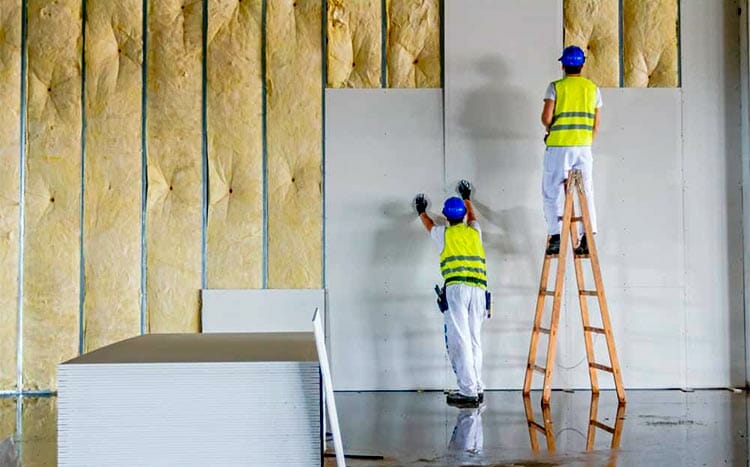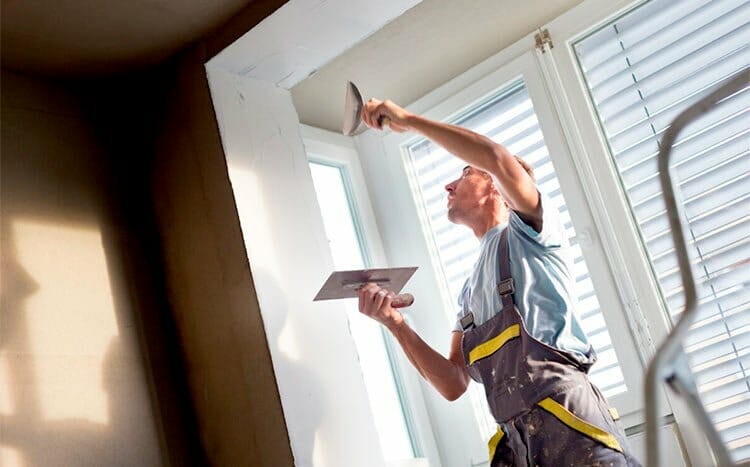Gypsum powder, a dehydrated mineral, is utilized in construction endeavors, while drywall consists of contemporary panels employed in the construction industry as a wall surfacing material, made from compressed Gypsum and paper.
Drywall is primarily made up of gypsum. Drywall is two paper sheets with compressed Gypsum in the middle. Gypsum is what gives drywall most of its admirable qualities like fire-resistance and the ability to effectively soundproof a room.
The main difference between gypsum and drywall is the fact that drywall is a largely man-made material while Gypsum is a mineral that occurs naturally. While drywall is primarily made of gypsum, it contains other materials. This includes paper sheets, glass fibers, and other added hardeners.
Here is what you should know about the differences between gypsum and drywall.

What we cover
ToggleWhat is drywall?
Drywall is a construction material that is made by sandwiching gypsum between two thick sheets of paper. It is commonly used by homeowners for partitioning interior spaces and it is popular mainly because of its fire-retarding qualities, ease of installation, and its ability to insulate and soundproof rooms. The fact that it is among the most affordable building materials also plays a significant role in its popularity.
What is Gypsum?
Gypsum is a material that is commonly used to create building materials. In order to be used as a building material, it is usually calcined — essentially exposing it to high temperatures. And when it is thereafter ground and mixed with water, it can then be used directly to create walls in homes.
While using gypsum to plaster walls usually yields higher quality finishes, and while it results in walls that have better soundproofing and insulating effect than drywall, it isn’t as popular as drywall. This is mainly because applying it is time-consuming. It also requires a lot of skill and tends to be quite labor-intensive.
Difference between Drywall and Gypsum
As construction materials, drywall and gypsum have different characteristics. This usually translates to differences in benefits of using either in a home. Here is a breakdown of the differences between these two construction materials.
Cost
While the material costs of drywall and gypsum are comparably similar, the difference in cost usually comes when you consider the cost of installation. Installation of drywall is simpler and does not require skilled labor. Gypsum installation, on the other hand, requires a lot of skill in order to pull off.
Installing gypsum also takes more time. And given that one has to apply up to 3 coats of the gypsum in order to get a good finish — and this is after careful lath installation — it is no wonder that the costs of installing it tend to be relatively higher. Therefore, cost-wise, drywall is a better option.
Water-resistance
Gypsum has a tendency to absorb moisture and this usually makes it ill-fitted to handle rooms with high humidity. And while drywall contains a significant amount of gypsum too, this gypsum is usually encased between two thick sheets of paper. These sheets of paper provide some shielding against exposure to moisture, making drywall slightly more water-resistant than gypsum.
Practicality
While gypsum has great qualities as a building material, it is not a very practical material to work with. This is mainly because it usually features an extremely labor-intensive and time-consuming installation process. The process isn’t just costly but is also less forgiving of mistakes with the slightest of errors leading to cracking and weaker walls.
Drywall is the opposite. It is usually incredibly easy to install, doesn’t require advanced skills in order to install, and it is also less forgiving of mistakes. And while it sometimes presents a challenge with regards to mold problems, it is largely a great material that is not only easy to install, but also maintain. It is no wonder that it has been one of the most popular construction materials over the years.
Versatility
Drywall is generally more versatile than gypsum simply because it is easier to work with. It can easily be cut into different shapes and sizes. Different boards fit perfectly together. Filling up their joints is remarkably easier. And it is relatively lighter in weight.
The ease with which it can be installed expands its use as most homeowners increasingly opt for it as a go-to solution. As a result, it is often used to partition offices and rooms, fireproof garage walls, boost the soundproofing of existing walls, and even cover worn-out paneling.
While gypsum has the benefit of not being stiff and hard — which means that it can be applied comfortably around corners –, the fact that it features a complex installation process limits the number of activities or uses that it is typically applied to. The need to secure an elaborate system of laths in place and thereafter use multiple coats of plaster restricts its applicability.
Installation
Installing drywall is a simple process that starts with taking measurements, cutting drywall when it is necessary, and then attaching it by screwing it to the studs. After that, applying mud and then taping and sealing the joints follows. This is a simple process that most homeowners can do on their own as part a DIY project.
On the other hand, installing gypsum is a little bit more complicated. It is a process that usually starts with the time-consuming and labor-intensive process of installing laths. This step is necessary in order to ensure that the gypsum has somewhere to hold onto. And after installing the lath, one has to then mix the gypsum with water in the right proportions. And after getting the desired consistency, they then have to start applying the 3 needed gypsum coats.
The whole process of installing gypsum is fraught with complexities and typically requires skill in order to get great results. And while it tends to give a better finish, the challenges that come with its installation have caused a lot of homeowners to shy away from using it. Instead, most people prefer drywall for how easy it is to install and maintain.

Longevity
Gypsum is a tougher and harder material than sheets of paper. And since the surface of drywall is made up of paper, gypsum tends to win when it comes to longevity.
Repairs
In order to fix seriously damaged drywall, you have to cut out an area of the drywall that includes all the damaged parts, and then replace it with a drywall patch of the same dimensions. Securing it in place with a joint compound, sanding it, and then painting it will then complete the process.
Conducting repairs on gypsum is much easier since it is mainly made up of the same material that the joint compound is made up of. Therefore, you don’t have to go through the cut-out phase. You can just skim coat it to get the same high-quality results. And even in cases where the plaster is sagging, one can always use plaster pins to easily reattach the sagging piece and then use a skim coat to get a smoother finish.
The only problem with repairing gypsum has to do with the need for skilled laborers to do repairs. It is generally recommended to always use skilled persons to carry the repairs if you want high-quality repair results. As a result, turning it into a DIY project isn’t always a great idea.
This makes repairing drywall much simpler and easier than repairing gypsum.
Can you hang things on a Gypsum wall?
Yes, you can hang things on a gypsum wall in spite of it having a hardened surface.
Although the walls tend to be tougher to penetrate with a nail, using a screw usually provides an easy solution that doesn’t risk cracking the wall. And once you drive the screws into the walls, they are usually sturdy enough to handle the weight of most items that are typically hung on walls — like picture frames.
Another thing that makes them fit to hang things on is the fact that you can directly drive the screw onto the studs. Doing so will provide more support, something that will make it possible for you to even hang relatively heavier things on the walls.

Is Gypsum a cheap alternative to drywall?
No, gypsum is not a cheap alternative to drywall. When you consider the cost of materials, installation costs, and the labor-intensiveness of installation, drywall is still among the cheapest materials that anyone can use on internal walls. Overall, it is a cheaper and easier-to-install alternative to gypsum.
How much does it cost to hang drywall?
It typically costs between $1 and $3 per square foot to hang drywall with the average installation cost being about $1,843.
What are the different types of Gypsum and sheetrock?
Sheetrock is mainly classified into 7 general categories. There is Type X drywall which is fire-resistant, soundproof drywall, and regular drywall. In addition to these common types of drywall, there is also green, blue, purple, and paperless drywall.
Gypsum on the other hand is classified into two main categories. The first is anhydrite gypsum plaster. This gypsum is made by exposing gypsum to extreme temperatures that are as high as 1700C. The other type of gypsum is hemihydrate gypsum, which is essentially gypsum that is manufactured by heating it to temperatures well above 1700C.
FAQ's
Is drywall lighter than gypsum?
Yes, drywall is lighter than gypsum. This is because while drywall contains a significant amount of gypsum, it also contains other materials that are lighter. It includes the thick paper sheets that act as the front-facing surfaces. Furthermore, gypsum has more water content than drywall, and this too contributes to the difference in weight — with drywall being lighter.
Does drywall have gypsum in it?
Yes, drywall has gypsum in it. The gypsum is what is responsible for most of the drywall’s fire resistance and fireproofing qualities.
The gypsum is usually found sandwiched between sheets of paper. And it is sometimes mixed with other materials like glass fibers to make the drywall more resistant to fire.
Is gypsum dangerous?
Generally, gypsum is not dangerous to human beings provided it is properly used.
If it is ingested, it can be dangerous since it can literally clog your digestive system. And when it is inhaled, in its powdered form, it can cause serious respiratory irritation. This may result in sneezing, coughing, rhinorrhea, and uncontrolled nosebleeds.
Is gypsum the same as plaster?
Gypsum is virtually the same as plaster in that they contain the same chemical composition. It is only that in order to make plaster, the gypsum is usually heated at high temperatures in order to make it harder and a little more water-resistant. As a result, before using it, one has to first mix it with water.
Use this free service to get in touch with a good drywall contractor
If you need help figuring out which material will be perfect for your home, your first step should be visiting HomeGardenGuides.com. It offers a free service that quickly matches you with the top-voted local experts.
Using the website, you can get 3 estimates fast by real certified experts in your area in just 2 minutes. Here is how it works.
- You scroll to the top of the page and enter your Zip code.
- Answer questions about your remodeling needs and aspirations
- Your details will be forwarded to three local experts.
- You will then receive a price estimate for the job and some friendly advice.
IMPORTANT: There is no obligation to hire. This is a free tool and service to be used at your pleasure.













